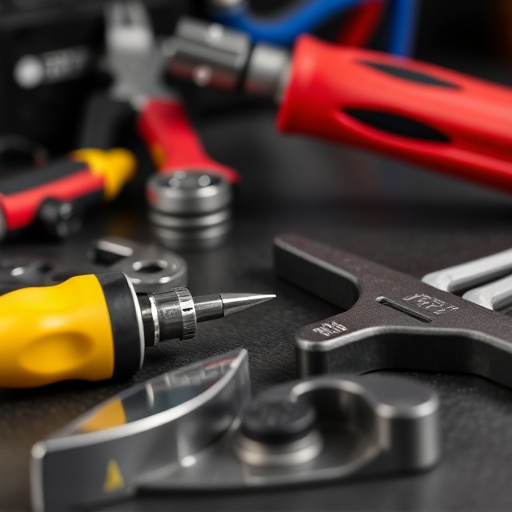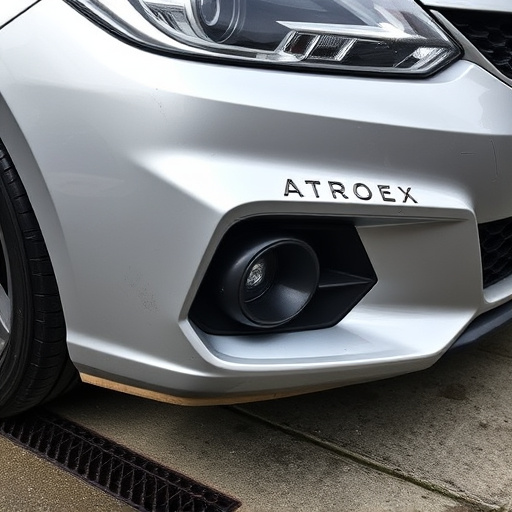The Mercedes High-Voltage Disconnect (HVD) is a critical safety mechanism for modern luxury vehicles, isolating high-voltage circuits during maintenance and repairs, reducing risks of power surges or shorts, and enhancing technician safety. Performing a safe HVD before accessing the high-voltage fuse box is essential for efficient and secure repair processes, particularly in collision scenarios, allowing specialists to focus on intricate repairs with peace of mind. This step-by-step guide details locating and isolating high-voltage components around the battery, powering off the vehicle, and securely removing connectors to ensure worker safety during Mercedes high-voltage disconnect procedures.
Mercedes owners often marvel at the advanced technology under their hoods. However, understanding critical components like the high-voltage (HV) system is essential for safe maintenance. This article delves into the intricate world of Mercedes high-voltage disconnect procedures. We explore why isolating the HV circuit before accessing fuses is paramount to prevent damage and ensure safety during repairs. By following a step-by-step guide, you’ll master this crucial technique.
- Understanding Mercedes High-Voltage Disconnect
- Why Conduct Before High-Voltage Fuse Access
- Step-by-Step Guide to Safe Disconnection Procedure
Understanding Mercedes High-Voltage Disconnect

Understanding Mercedes High-Voltage Disconnect
In modern luxury vehicles like Mercedes Benz, high-voltage systems have become increasingly common, powering electric and hybrid components essential for advanced safety features and improved performance. The Mercedes high-voltage disconnect (HVD) is a critical component designed to safely isolate these high-voltage circuits during maintenance or repair, particularly when accessing the high-voltage fuse box. This mechanism ensures that no electrical power flows through sensitive areas, significantly enhancing the safety of technicians conducting repairs on these sophisticated systems.
The HVD plays a pivotal role in streamlining Mercedes benz repair processes, especially for car dent removal and other intricate tasks involving electric components. By disconnecting the high voltage at the source, technicians can work with greater peace of mind, knowing that accidental power surges or shorts are mitigated. This not only improves efficiency but also reduces the risk of damage to both the vehicle and the technician during what could otherwise be a challenging and potentially dangerous repair scenario.
Why Conduct Before High-Voltage Fuse Access

Conducting a Mercedes high-voltage disconnect before accessing the high-voltage fuse is a crucial step in safe and efficient automotive repair services. This preventative measure ensures that the electrical system is isolated, minimizing the risk of accidental discharge or short circuits during the restoration process. In the event of an automotive collision repair, where high-voltage components might be compromised, this initial disconnect acts as a safeguard, protecting both technicians and vehicles from potential harm.
By implementing this practice, car restoration specialists can focus on intricate repairs with greater peace of mind. It allows for systematic access to fuses, making it easier to diagnose issues and replace faulty parts without worrying about residual voltage. This meticulous approach is not just beneficial for Mercedes high-voltage systems but also applicable to various vehicle models, ensuring the highest standards of safety in automotive collision repair.
Step-by-Step Guide to Safe Disconnection Procedure

Performing a Mercedes high-voltage disconnect safely is crucial for both efficiency and safety during any repair or maintenance process. Here’s a step-by-step guide to ensure a secure disconnection:
1. Locate the High-Voltage Components: Begin by identifying the specific high-voltage components within your Mercedes vehicle, usually around the battery and electrical system. This includes high-voltage cables, connectors, and fuses.
2. Power Off and Ensure Safety: Before you begin any disconnection, ensure that the ignition is off and the vehicle’s power is completely cut off. Use appropriate safety gear like gloves to protect yourself from potential shocks. Verify that no electrical components are active or connected.
3. Isolate High-Voltage Lines: Using a set of insulated tools, carefully isolate each high-voltage line one by one. Start with the most distant lines and work your way towards the battery. Ensure that all connections are securely loosened without damaging the cables or connectors.
4. Remove Connectors: After isolating the wires, remove the connectors from the battery terminals. Always handle connectors and components carefully to avoid any damage during the disconnection process.
5. Final Checks: Double-check that all high-voltage lines are completely disconnected and isolated. This step is vital for preventing any accidental power surges or shocks while performing other repair tasks, especially in fleet repair services or automotive restoration work.
Mercedes high-voltage disconnect procedures are crucial for safe and efficient maintenance. By understanding the purpose of these systems, particularly why disconnection should be conducted before accessing high-voltage fuses, automotive enthusiasts can ensure their work is both effective and secure. Following a structured guide guarantees minimal risk and swift troubleshooting, making it a valuable skill for any Mercedes owner or mechanic to possess. Remember, proper safety protocols are key when dealing with high-voltage components in modern vehicles like Mercedes.














